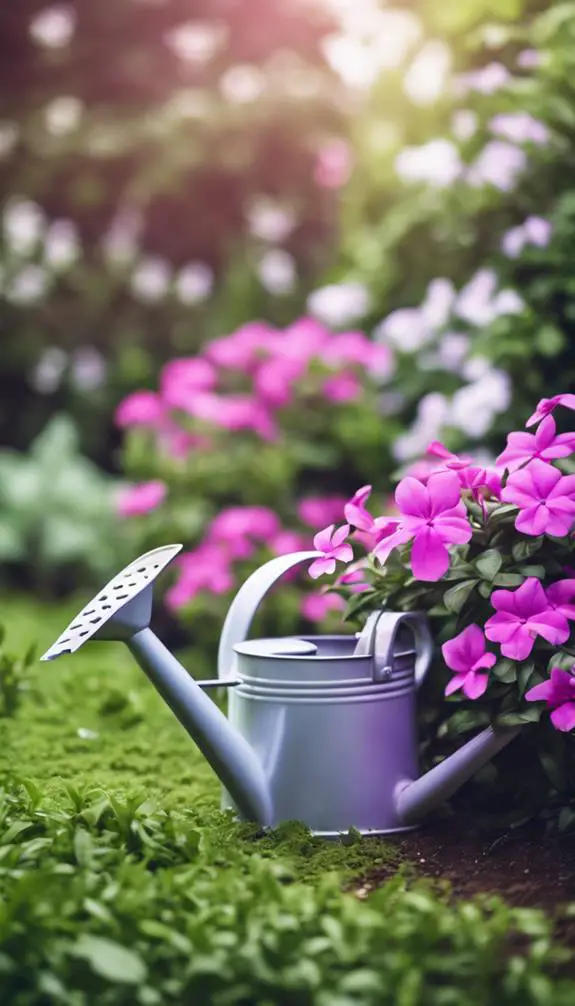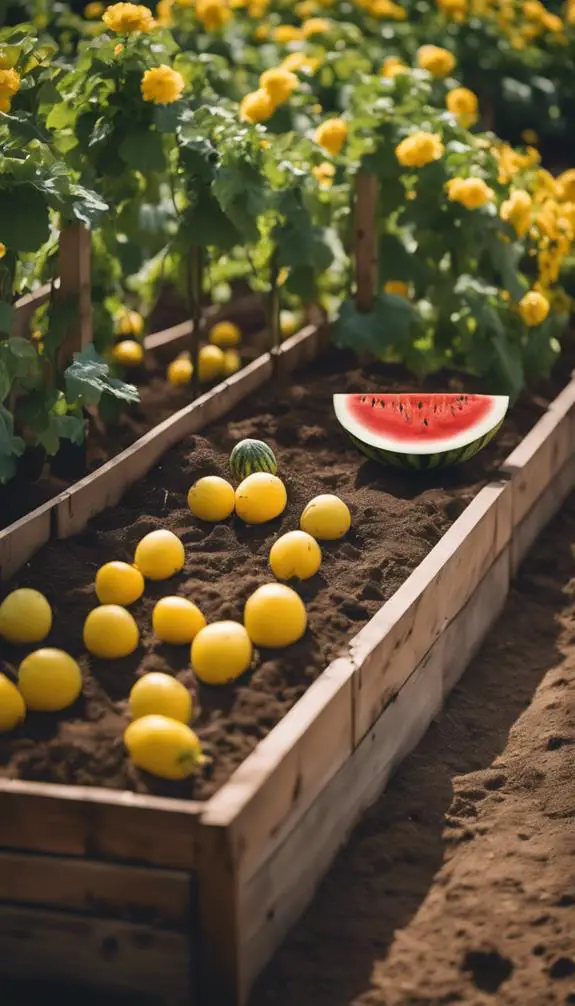As you begin to explore the world of herbal teas, you'll find that lemon balm is a delightful addition to your repertoire. With its light, citrusy flavor and calming properties, it's no wonder this tea is a favorite among many. To get started, you'll need to gather fresh lemon balm leaves, choosing the right tools and measuring the perfect amount for your brew. But that's just the beginning – the real magic happens when you heat the water to the ideal temperature and steep the leaves to perfection. And what comes next will transform your tea-making experience…
Summary
- Harvest fresh lemon balm leaves in the morning, after dew has dried, to ensure optimal flavor and aroma.
- Use one teaspoon of dried or one tablespoon of fresh lemon balm leaves for every 8 oz of water for a perfectly balanced tea.
- Heat water to 160°F-170°F and steep the leaves for 5-7 minutes to release the optimal amount of flavor and potency.
- Adjust the tea proportion to suit your taste buds, as too little may result in a weak tea and too much may be overpowering.
- Store lemon balm tea in an airtight container in the fridge to maintain its flavor and aroma for a longer period.
Gather Fresh Lemon Balm Leaves

Among the lush greenery of your herb garden, carefully select a handful of fresh lemon balm leaves, choosing those with a vibrant color and a subtle sheen.
Be mindful of any signs of pests, such as spider mites, aphids, or whiteflies, which can weaken the plant and affect the flavor of your tea.
When harvesting, pinch or cut off the top sets of leaves to encourage bushy growth and prevent the plant from flowering.
Harvesting in the morning, after the dew has dried, will help prevent moisture from affecting the leaves.
Follow these harvesting tips to guarantee you're gathering the best quality leaves for your lemon balm tea.
Choose the Right Tea Tools
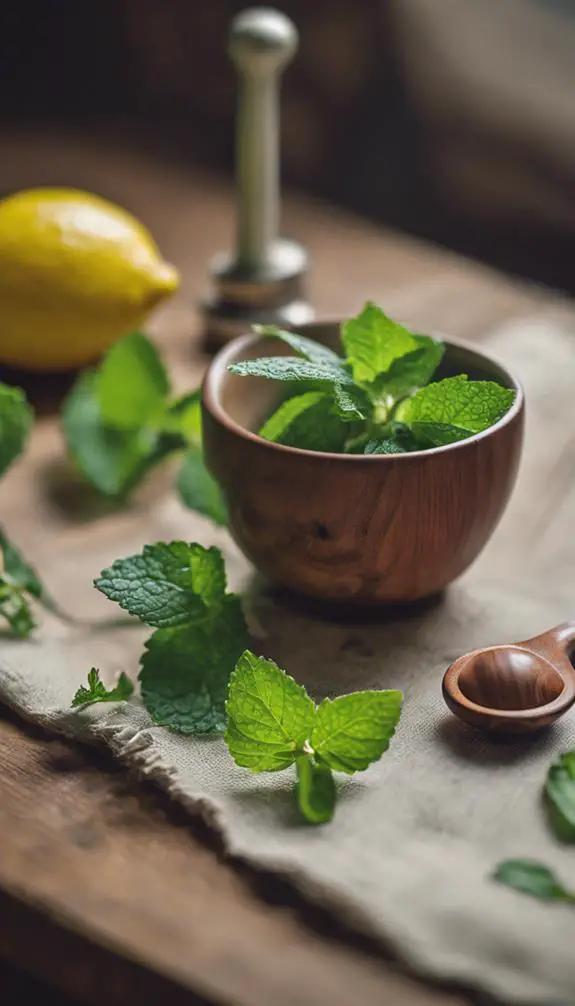
Your herb garden's bounty is now ready to be transformed into a soothing cup of lemon balm tea.
To reveal the full potential of your fresh leaves, you'll need the right tea tools.
Start by selecting a perfect teapot that allows for ideal steeping and infusion.
Look for one made from materials like ceramic, glass, or stainless steel, which won't impart flavors or react with the herbs.
Next, consider your tea infuser options.
You can choose from metal or silicone infusers, or even a simple muslin bag.
Whatever you choose, make sure it allows the leaves to unfurl and release their flavors and aromas.
With the right tools, you'll be able to brew a truly exceptional cup of lemon balm tea.
Measure the Perfect Amount
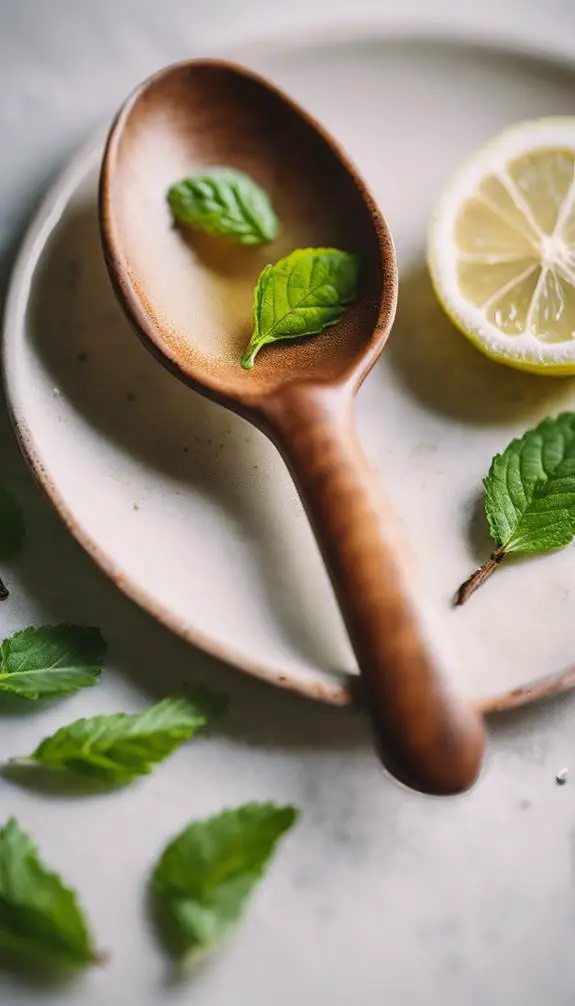
With your tea tools in place, it's time to focus on the most critical aspect of brewing lemon balm tea: measuring the perfect amount.
The ideal lemon ratio is one teaspoon of dried lemon balm leaves or one tablespoon of fresh leaves for every 8 oz of water.
For a stronger tea, you can adjust the tea proportion to one and a half teaspoons of dried leaves or two tablespoons of fresh leaves per 8 oz of water.
Remember, the key is to find the balance that suits your taste buds.
Too little lemon balm, and the tea might be too weak; too much, and it might be overpowering.
Heat Water to Ideal Temperature
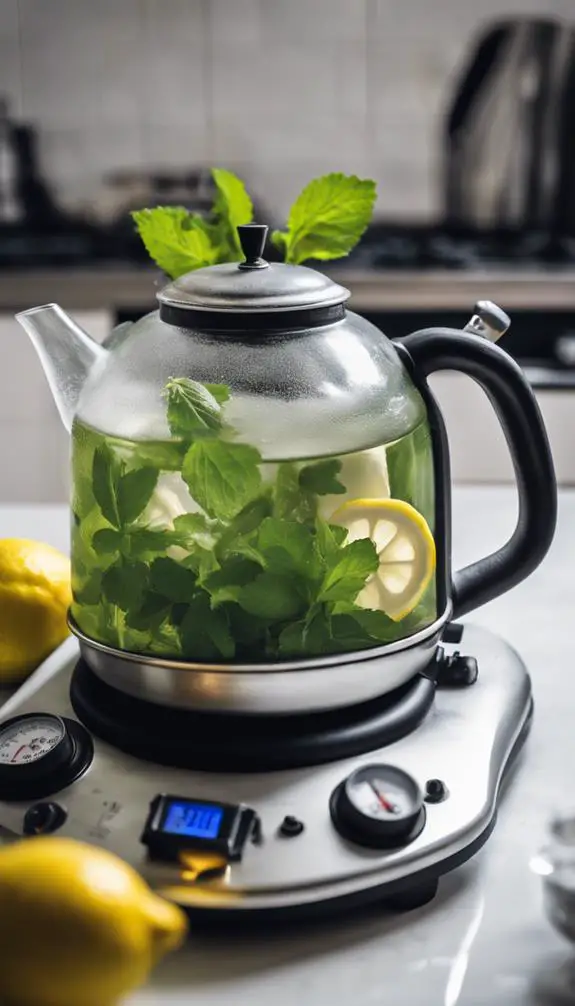
You'll want to heat your water to the perfect temperature to bring out the best flavor and aroma of your lemon balm tea.
Aim for a temperature between 160°F and 170°F, as boiling water can be too harsh for the delicate leaves.
Take about 5-7 minutes to heat the water to the ideal temperature, ensuring a smooth and invigorating brew.
Water Temperature Guide
As you prepare to brew your lemon balm tea, this is vital to get the water temperature just right.
For herbal infusions like lemon balm, the ideal temperature is between 160°F and 170°F. This allows the delicate flavors and aromas to unfold without becoming bitter.
In the world of tea culture, precision temperature control is key to releasing the full potential of your brew. Aim for a temperature that's slightly below boiling, as boiling water can scald the leaves and create an unbalanced flavor profile.
Optimal Heating Time
Heating water to the ideal temperature for lemon balm tea requires some finesse, but don't worry, it's a skill you can master with a bit of practice.
To achieve the perfect heating time, you'll want to aim for a temperature between 160°F and 170°F (71°C to 77°C). This allows the delicate flavors and aromas of the lemon balm to shine through without becoming bitter.
For perfect heat control, use a thermometer to monitor the temperature. Once you've reached the ideal range, remove the water from the heat source and let it steep for 5-7 minutes.
This steeping timing allows the flavors to meld together, creating a revitalizing and soothing cup of tea.
Steep the Lemon Balm Leaves
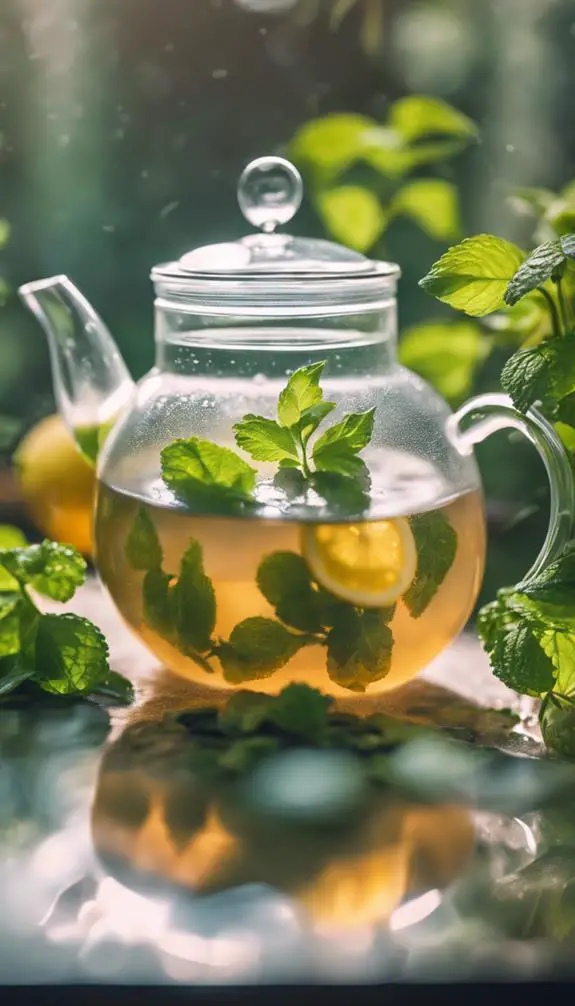
Steeping the lemon balm leaves is where the magic happens, and it's surprisingly easy.
To release the balm benefits, you'll want to steep the leaves for the right amount of time. Aim for 5-7 minutes, depending on your desired level of flavor and potency. The longer you steep, the more pronounced the flavor will be.
As you steep, the leaves will start to unfurl and release their oils, which will infuse into the tea. This process allows the leaf longevity to shine, as the leaves' natural antioxidants and nutrients are extracted into the liquid.
During this time, you can sit back, relax, and let the tea work its magic.
Strain the Tea Leaves Carefully

Your tea-infusing timeout is almost over, and it's time to separate the liquid gold from the solids.
Now, it's vital to strain the tea leaves carefully to guarantee you're left with a smooth, refined brew. To do this, use a fine-mesh strainer or tea infuser to catch those delicate leaves.
If you're using loose-leaf tea, gently pour the liquid into another container, making sure not to disturb the leaves. This strain technique is essential for preserving the tea leaf quality and avoiding any bitter flavors.
Take your time, and be gentle – you want to coax out the best flavor from those leaves. With the right strain techniques, you'll be rewarded with a revitalizing, citrusy brew that's perfect for sipping.
Add Honey to Taste Sweetly
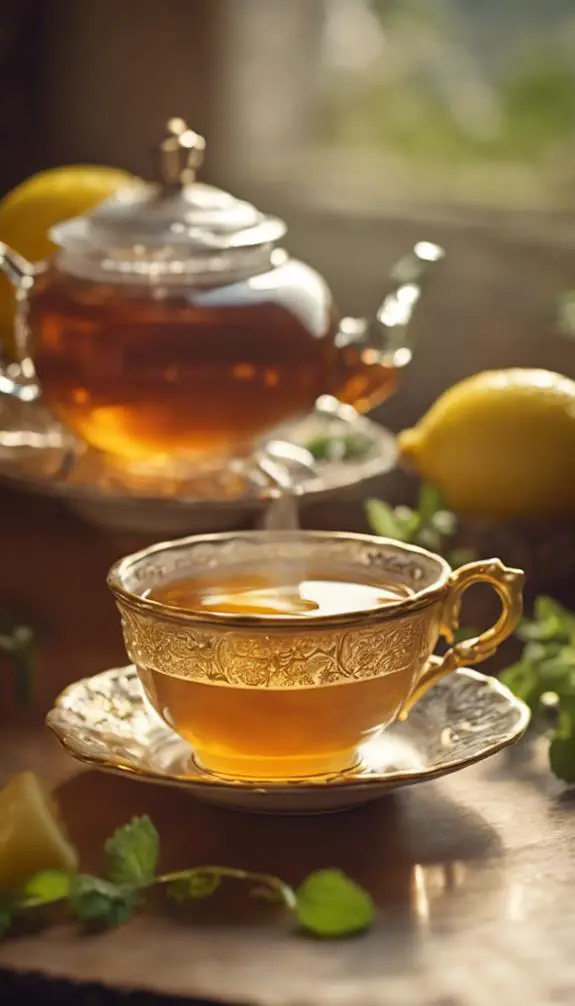
Now that you've carefully strained your lemon balm tea, it's time to add a touch of sweetness with honey, which not only tastes great but also brings its own set of soothing qualities to the table.
When you add honey to your tea, you can control the level of sweetness to your liking, whether you prefer a hint of sweetness or a more pronounced flavor.
Honey's Soothing Qualities
The sweetener of choice for many herbal tea enthusiasts, honey, brings more to the table than just its rich flavor profile when added to lemon balm tea.
You'll be delighted to know that honey's history dates back thousands of years, with ancient civilizations revering it for its medicinal properties.
As you savor your lemon balm tea, honey's soothing qualities will come into play, providing relief from sore throats and coughs.
Honey benefits also extend to its antibacterial and anti-inflammatory properties, which can help calm digestive issues and promote a good night's sleep.
With its natural energy-boosting properties, honey is the perfect addition to your lemon balm tea, making it a delicious and nutritious beverage.
Adding Honey to Tea
Sweet indulgence awaits as you stir in a spoonful of honey into your lemon balm tea, transforming it into a comforting treat that's both soothing and satisfying.
As you add honey, you're not only sweetening your tea but also reaping its health benefits. Honey is packed with antioxidants, has antibacterial properties, and can even soothe a sore throat.
If you're looking for sweetener alternatives, consider trying maple syrup or agave nectar for a different flavor profile. However, honey's unique properties make it a popular choice for many tea enthusiasts.
When adding honey to your lemon balm tea, start with a small amount and adjust to taste, as the sweetness level can quickly overpower the delicate flavor of the lemon balm.
Sweetness Level Control
With each spoonful of honey added to your lemon balm tea, you're not only balancing the flavors but also tailoring the sweetness level to your liking.
As you experiment with different honey amounts, you'll discover that the subtle sweetness complements the herb's citrusy notes.
For those who prefer an alternative to honey, sugar substitutes like stevia or monk fruit can be used to achieve a similar effect.
However, be mindful of the flavor profiles, as some sugar substitutes can alter the tea's character.
When adding honey or substitutes, start with a small amount and adjust to taste, ensuring the sweetness level harmonizes with the tea's delicate flavors.
Consider Adding Other Herbs

Lemon balm's citrusy charm is undeniable, but blending it with other herbs can elevate its flavor and benefits.
You can create unique herbal blends by combining lemon balm with other herbs that complement its bright, citrusy flavor.
Try pairing it with calming herbs like chamomile or lavender for a soothing tea, or with peppermint for an invigorating twist.
Experiment with different flavor combos to find the perfect blend for your taste buds.
For a fruity spin, add some dried berries like blueberries or raspberries to your tea.
Store Tea in the Fridge

When you're not sipping on your freshly brewed lemon balm tea, you'll want to store it in the fridge to keep it fresh for a longer period.
By doing so, you'll maintain the tea's flavor and aroma, which can quickly degrade if left at room temperature.
Proper storage is key, so let's explore some essential tea storage tips to keep your brew fresh and delicious.
Tea Storage Tips
By virtue of its delicate flavor and aroma, lemon balm tea requires careful storage to preserve its quality.
You'll want to store your tea in an airtight container, like a glass jar or a paper bag, to protect it from air, light, and moisture.
This will help maintain tea freshness and prevent the tea from becoming stale or bitter.
When storing tea in the fridge, keep it away from strong-smelling foods, as the tea can absorb odors easily.
You can also store it in the freezer to prolong its shelf life.
Just be sure to label the container with the date and contents, so you can easily keep track of your tea storage methods.
Freshness Maintenance Key
You've taken the first step in preserving your lemon balm tea's quality by storing it in an airtight container.
Now, this is crucial to maintain that freshness by storing it in the fridge. This will help lock in the balm benefits, ensuring your tea remains potent and flavorful.
The fridge's cool temperature will slow down the oxidation process, keeping your tea fresh for a longer period. By doing so, you'll release the freshness secrets of your lemon balm tea, enjoying its calming and uplifting effects with every sip.
Refrigerate After Brewing
Inside your fridge, a special spot awaits your freshly brewed lemon balm tea.
You've worked hard to create a delicious and soothing brew, and now it's time to preserve its flavor and aroma.
Refrigerate your tea to guarantee fresh storage and maximize its shelf life. The cooling effects of the fridge will slow down the oxidation process, keeping your tea fresh for a longer period.
Store the tea in an airtight container to prevent contamination and other flavors from affecting its taste.
Serve Hot or Iced Tea
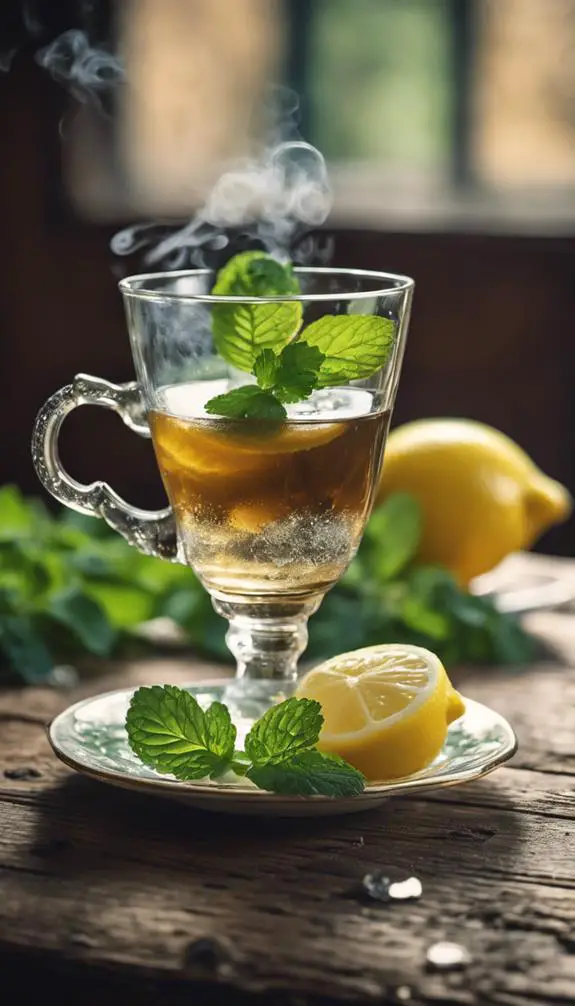
When you're in the mood for a soothing cup, you can enjoy lemon balm tea either hot or iced, depending on your personal preference and the occasion.
As a versatile beverage option, it seamlessly fits into various tea cultures. Serve it hot on a chilly morning to warm your senses or as a calming pick-me-up during a busy day.
Alternatively, brew a revitalizing iced tea for a rejuvenating drink on a warm summer afternoon. You can also experiment with different flavor combinations, such as adding honey or mint, to create a unique twist on this herbal tea.
With lemon balm tea, the possibilities are endless, and it's up to you to explore and find your perfect cup.
Enjoy the Calming Benefits

Two cups of lemon balm tea a day can become your new self-care ritual, helping to melt away stress and anxiety.
As you sip on this calming brew, you'll start to feel your worries fade away, replaced by a sense of tranquility and relaxation.
Lemon balm tea is particularly effective at calming anxiety, thanks to its high concentration of rosmarinic acid and flavonoids.
It can also help soothe insomnia, making it easier to fall asleep and stay asleep.
By incorporating lemon balm tea into your daily routine, you'll be taking a proactive approach to managing stress and promoting a better night's rest.
With regular consumption, you can expect to feel more centered, focused, and prepared to take on whatever life throws your way.
Tips for Growing Lemon Balm
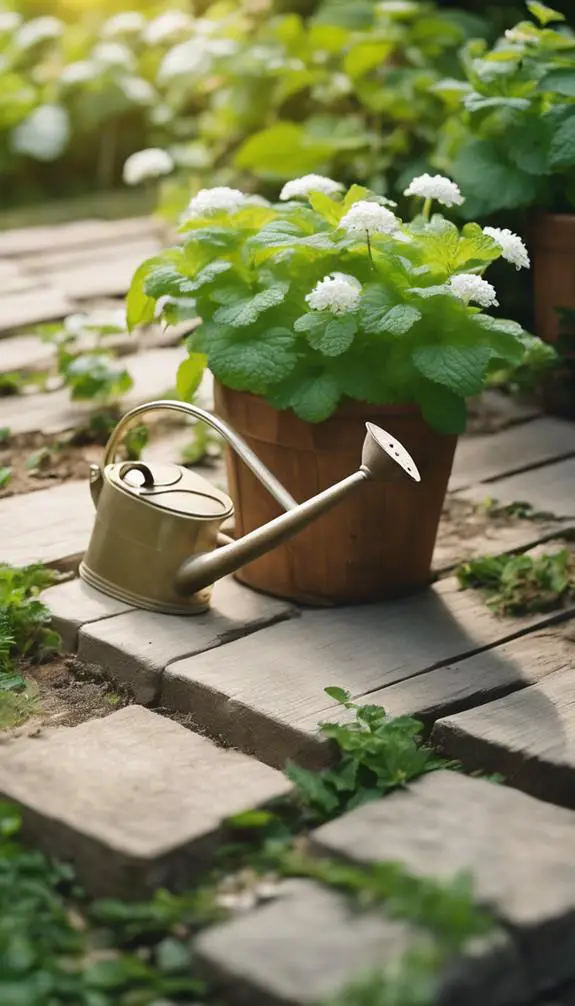
Growing lemon balm in your own backyard or indoor garden can be a rewarding experience, especially with the right techniques.
To get started, you'll want to choose a spot that receives partial shade to full sun, as lemon balm thrives in bright light.
When it comes to soil preferences, opt for well-draining soil with a pH between 6.0 and 7.0.
Lemon balm care is relatively low maintenance; simply water regularly, but avoid overwatering, which can lead to root rot.
Fertilize lightly during the growing season, and prune regularly to encourage bushy growth.
Variations for Lemon Balm Tea

Get creative with your lemon balm tea by experimenting with various flavor combinations and ingredients.
You can create unique lemon balm blends by mixing it with other herbs like peppermint, chamomile, or hibiscus. Try adding a squeeze of fresh lime or orange juice for a burst of citrus flavor.
For a sweet twist, add a spoonful of honey or a drizzle of maple syrup. You can also infuse your lemon balm tea with spices like cinnamon, ginger, or cloves for an herbal twist.
Experiment with different ratios of lemon balm to other ingredients to find your perfect cup. Don't be afraid to get adventurous and come up with your own signature flavors – the possibilities are endless!
FAQs
Can I Use Dried Lemon Balm Leaves Instead of Fresh Ones?
You can definitely use dried lemon balm leaves, which offer benefits like longer shelf life and easier storage. The dried form will still provide a lovely flavor profile, although it might be slightly milder than fresh leaves, so adjust the steeping time to your taste.
How Long Does Lemon Balm Tea Stay Fresh in the Fridge?
You'll be happy to know that your lemon balm tea can stay fresh in the fridge for up to 3-5 days when stored in an airtight container, and its shelf life can be extended to 2 weeks with proper fridge storage and tea shelf organization.
Can I Add Lemon Slices to My Lemon Balm Tea?
You're wondering if you can add lemon slices to your brew, and the answer is yes! You'll create a citrus twist, blending the subtle sweetness of lemon balm with the tang of fresh lemon, resulting in a fresh fusion that'll elevate your tea game.
Is Lemon Balm Tea Safe for Pregnant Women to Consume?
You're wondering if lemon balm tea is safe for pregnant women to consume, and the answer is yes! It's a great herbal remedy that can provide pregnancy benefits, like reducing anxiety and promoting relaxation, making it a wonderful addition to your prenatal care routine.
Can I Grow Lemon Balm Indoors in a Pot?
You can grow lemon balm indoors in a pot by selecting a well-draining soil mix and a container with good air circulation, then providing indirect sunlight and consistent watering, making pot care a breeze!
Conclusion
Now that you've mastered the art of making lemon balm tea, it's time to get creative! Experiment with different blends and flavors to find your perfect cup. Try pairing it with other herbs, spices, or fruits to create a unique twist. And don't forget to share your newfound skills with friends and family – they'll appreciate the calming benefits of this soothing tea. Happy sipping!


